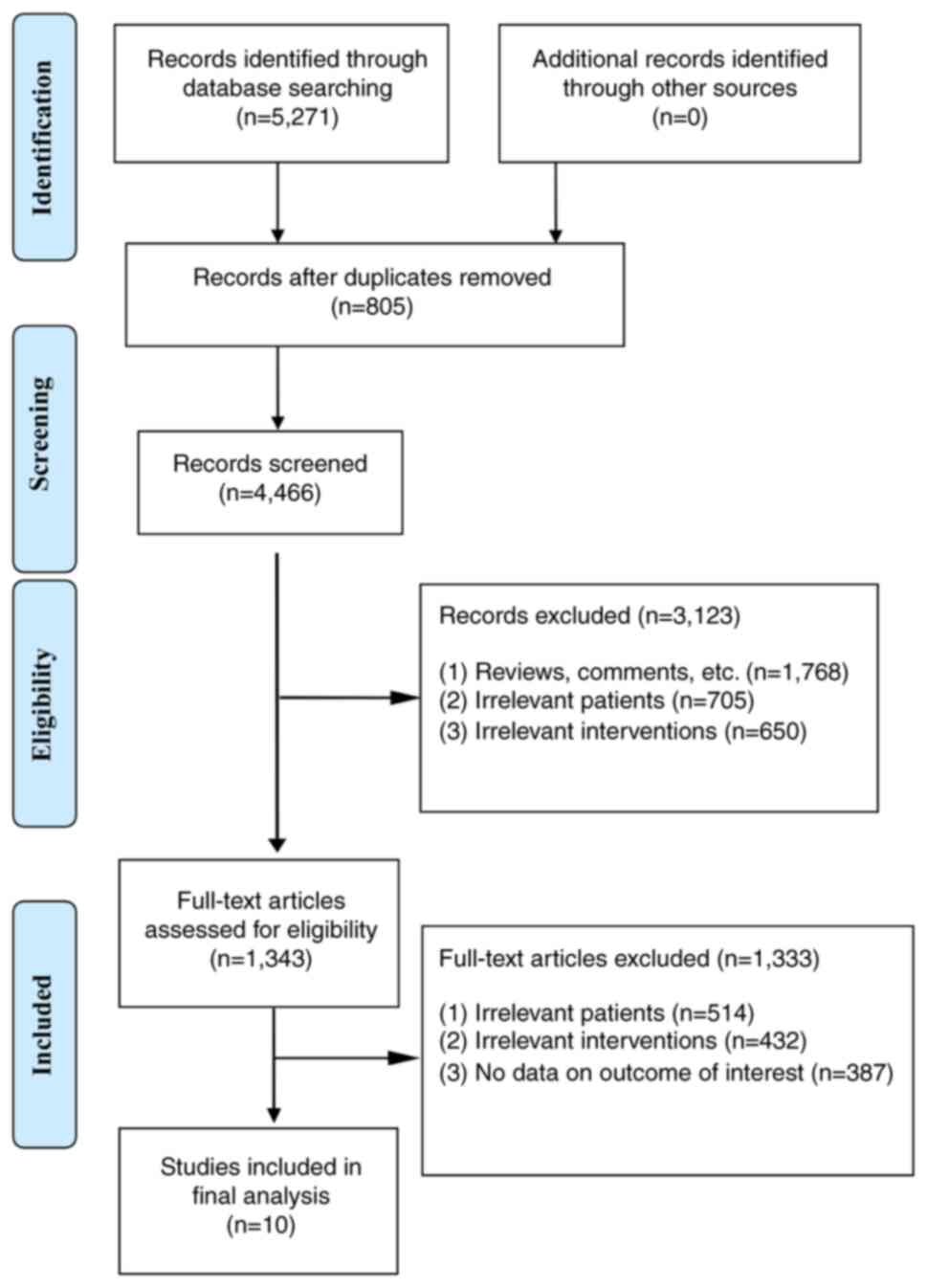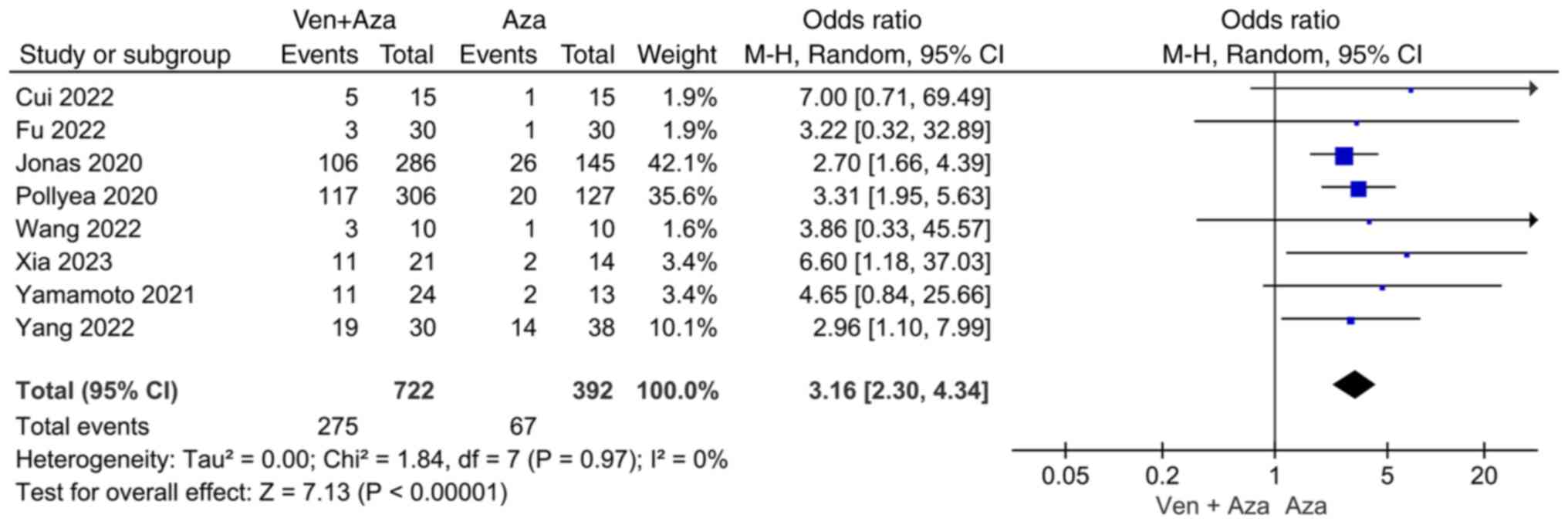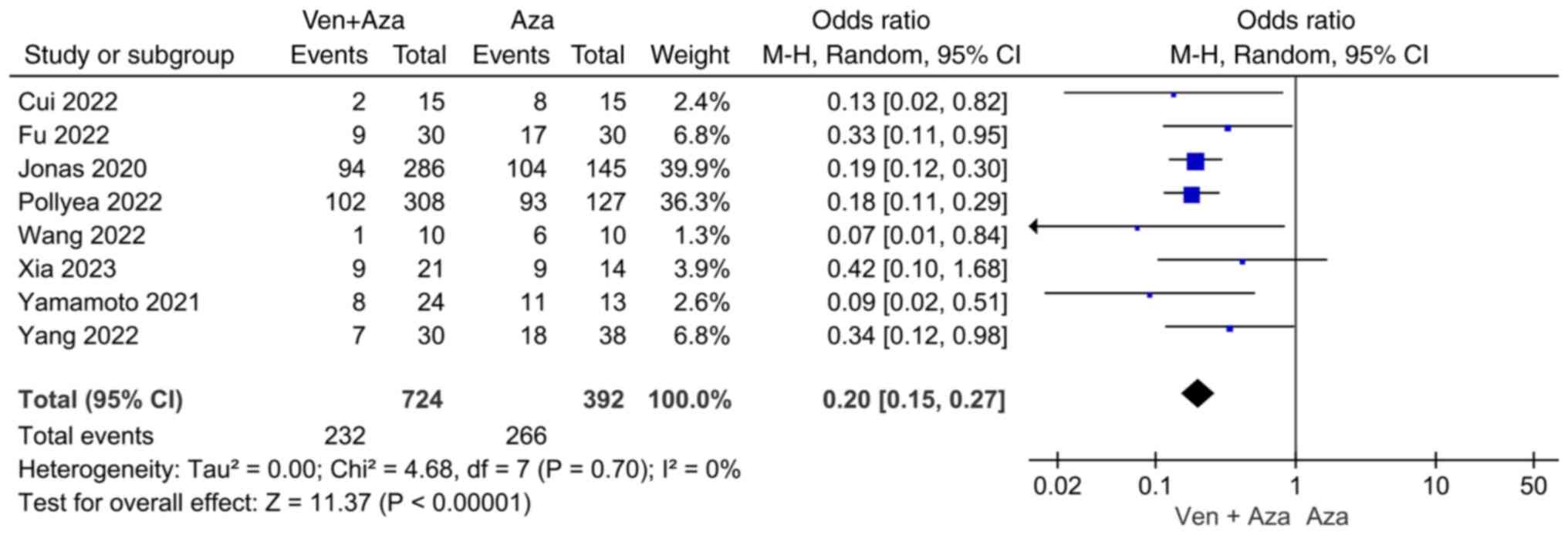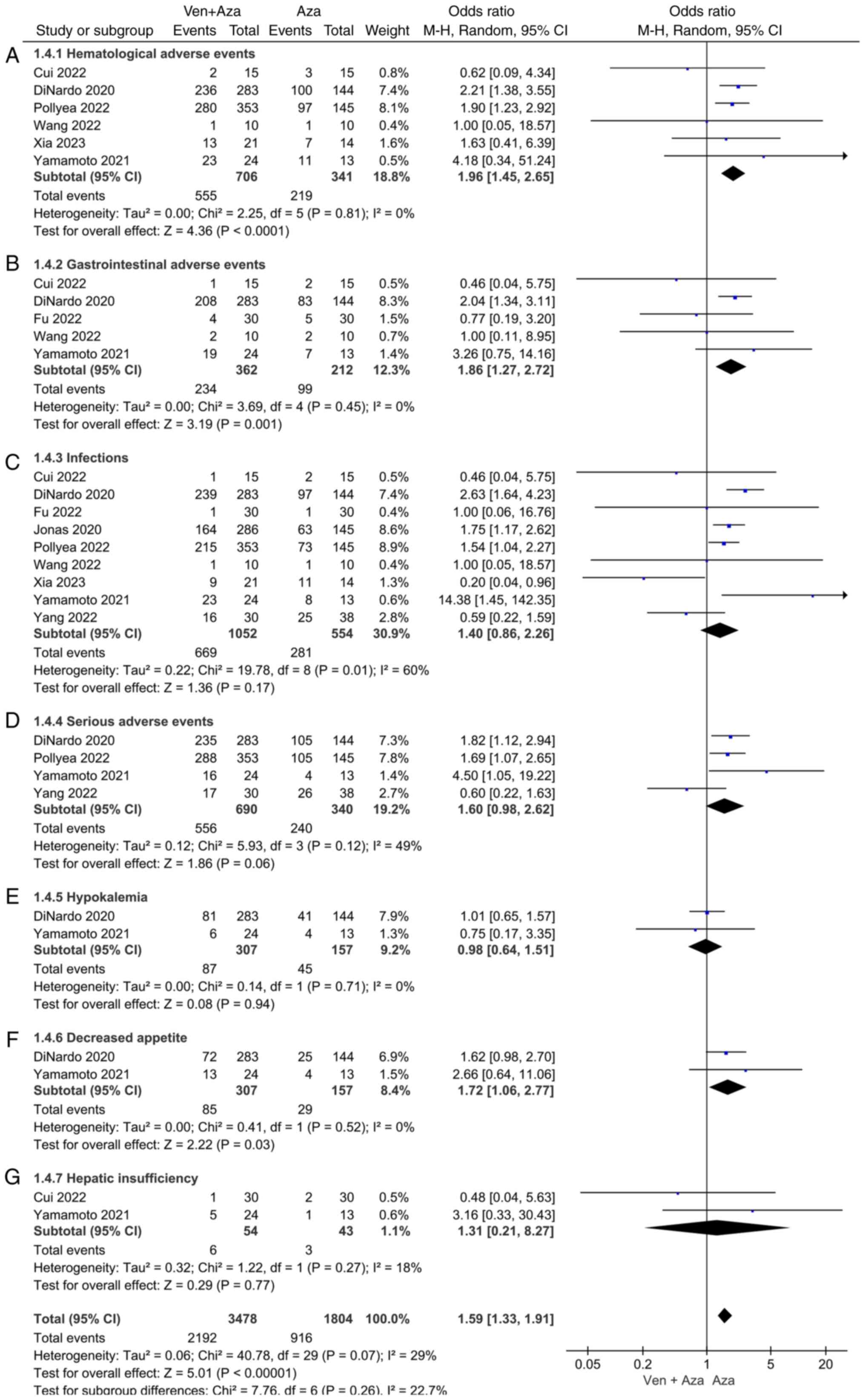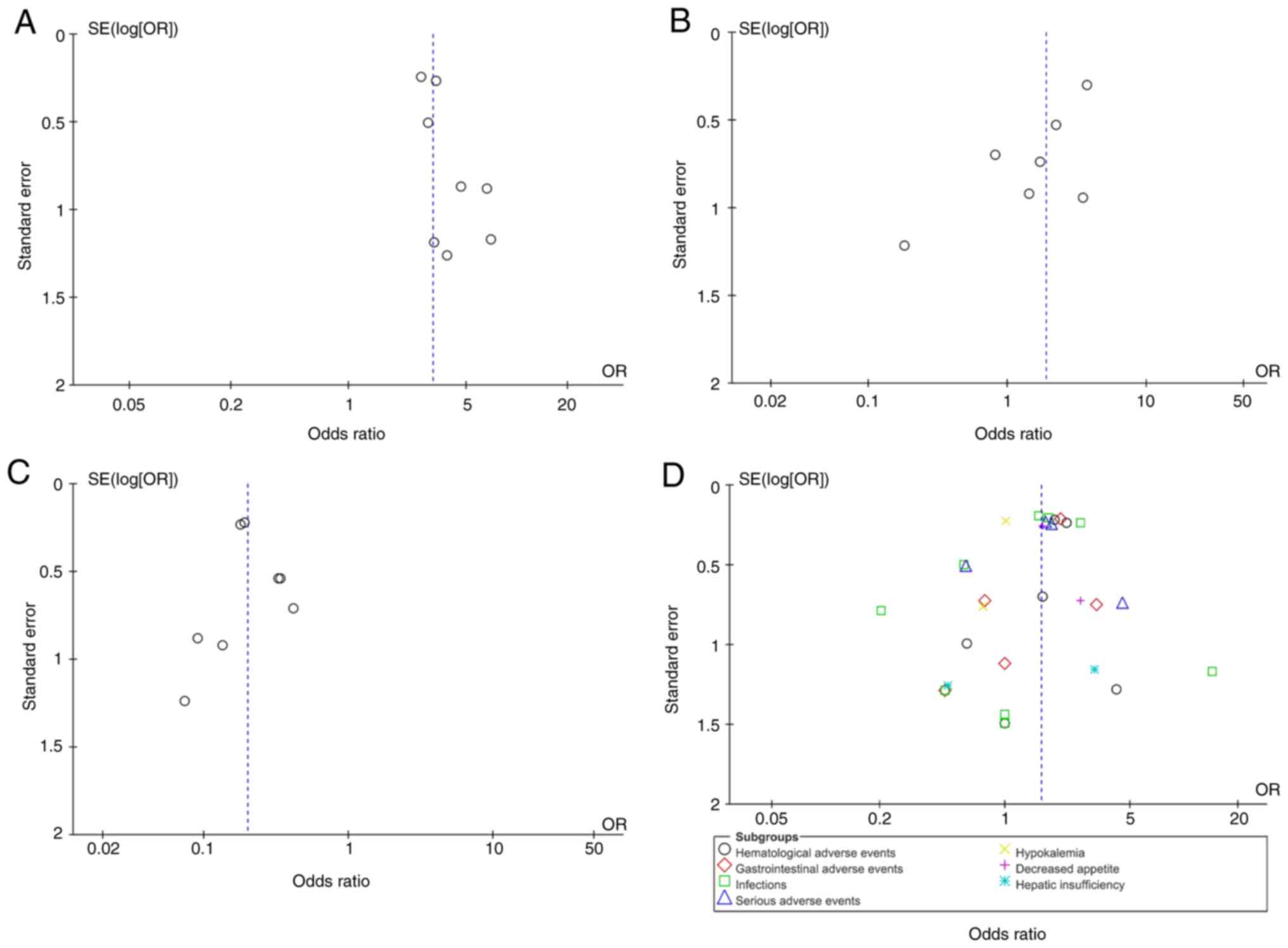|
1
|
Konopleva M, Pollyea DA, Potluri J, Chyla
B, Hogdal L, Busman T, McKeegan E, Salem AH, Zhu M, Ricker JL, et
al: Efficacy and biological correlates of response in a phase II
study of venetoclax monotherapy in patients with acute myelogenous
leukemia. Cancer Discov. 6:1106–1117. 2016.PubMed/NCBI View Article : Google Scholar
|
|
2
|
Kadia TM, Reville PK, Wang X, Rausch CR,
Borthakur G, Pemmaraju N, Daver NG, DiNardo CD, Sasaki K, Issa GC,
et al: Phase II study of venetoclax added to cladribine plus
low-dose cytarabine alternating with 5-azacitidine in older
patients with newly diagnosed acute myeloid leukemia. J Clin Oncol.
40:3848–3857. 2022.PubMed/NCBI View Article : Google Scholar
|
|
3
|
Richard-Carpentier G and DiNardo CD:
Venetoclax for the treatment of newly diagnosed acute myeloid
leukemia in patients who are ineligible for intensive chemotherapy.
Ther Adv Hematol. 10(2040620719882822)2019.PubMed/NCBI View Article : Google Scholar
|
|
4
|
Pollyea DA, Amaya M, Strati P and
Konopleva MY: Venetoclax for AML: Changing the treatment paradigm.
Blood Adv. 3:4326–4335. 2019.PubMed/NCBI View Article : Google Scholar
|
|
5
|
Wei AH, Strickland SA Jr, Hou JZ, Fiedler
W, Lin TL, Walter RB, Enjeti A, Tiong IS, Savona M, Lee S, et al:
Venetoclax combined with low-dose cytarabine for previously
untreated patients with acute myeloid leukemia: Results from a
phase Ib/II study. J Clin Oncol. 37:1277–1284. 2019.PubMed/NCBI View Article : Google Scholar
|
|
6
|
DiNardo CD, Pratz KW, Letai A, Jonas BA,
Wei AH, Thirman M, Arellano M, Frattini MG, Kantarjian H, Popovic
R, et al: Safety and preliminary efficacy of venetoclax with
decitabine or azacitidine in elderly patients with previously
untreated acute myeloid leukaemia: A non-randomised, open-label,
phase 1b study. Lancet Oncol. 19:216–228. 2018.PubMed/NCBI View Article : Google Scholar
|
|
7
|
Vasu S, Kohlschmidt J, Mrózek K, Eisfeld
AK, Nicolet D, Sterling LJ, Becker H, Metzeler KH, Papaioannou D,
Powell BL, et al: Ten-year outcome of patients with acute myeloid
leukemia not treated with allogeneic transplantation in first
complete remission. Blood Adv. 2:1645–1650. 2018.PubMed/NCBI View Article : Google Scholar
|
|
8
|
Singh R, Letai A and Sarosiek K:
Regulation of apoptosis in health and disease: The balancing act of
BCL-2 family proteins. Nat Rev Mol Cell Biol. 20:175–193.
2019.PubMed/NCBI View Article : Google Scholar
|
|
9
|
DiNardo CD, Pratz K, Pullarkat V, Jonas
BA, Arellano M, Becker PS, Frankfurt O, Konopleva M, Wei AH,
Kantarjian HM, et al: Venetoclax combined with decitabine or
azacitidine in treatment-naive, elderly patients with acute myeloid
leukemia. Blood. 133:7–17. 2019.PubMed/NCBI View Article : Google Scholar
|
|
10
|
Choi JH, Bogenberger JM and Tibes R:
Targeting apoptosis in acute myeloid leukemia: Current status and
future directions of BCL-2 inhibition with venetoclax and beyond.
Target Oncol. 15:147–162. 2020.PubMed/NCBI View Article : Google Scholar
|
|
11
|
Pollyea DA, Stevens BM, Jones CL, Winters
A, Pei S, Minhajuddin M, D'Alessandro A, Culp-Hill R, Riemondy KA,
Gillen AE, et al: Venetoclax with azacitidine disrupts energy
metabolism and targets leukemia stem cells in patients with acute
myeloid leukemia. Nat Med. 24:1859–1866. 2018.PubMed/NCBI View Article : Google Scholar
|
|
12
|
Yue X, Chen Q and He J: Combination
strategies to overcome resistance to the BCL2 inhibitor venetoclax
in hematologic malignancies. Cancer Cell Int.
20(524)2020.PubMed/NCBI View Article : Google Scholar
|
|
13
|
Garciaz S, Hospital MA, Alary AS, Saillard
C, Hicheri Y, Mohty B, Rey J, D'Incan E, Charbonnier A, Villetard
F, et al: Azacitidine plus venetoclax for the treatment of relapsed
and newly diagnosed acute myeloid leukemia patients. Cancers
(Basel). 14(2025)2022.PubMed/NCBI View Article : Google Scholar
|
|
14
|
Cui H, Liu Z, Jin M, Wang D and Liu L:
Efficacy and safety of azacytidine and BCL-2 inhibitors in the
treatment of acute myeloid leukemia. Syst Med. 7:4–7. 2022.
|
|
15
|
Wang W, Luo Q, Chen Q, Pang A and Fang K:
Analysis of the clinical efficacy of azacytidine + venetoclax in
the treatment of elderly patients with relapsed refractory acute
myeloid leukemia. Evid Based Complement Alternat Med.
2022(8691835)2022.PubMed/NCBI View Article : Google Scholar
|
|
16
|
Xia L, Tian W, Zhao Y, Jiang L, Qian W,
Jiang L, Ge L, Li J, Jin F and Yang M: Venetoclax and azacitidine
in Chinese patients with untreated acute myeloid leukemia
ineligible for intensive chemotherapy. Signal Transduct Target
Ther. 8(176)2023.PubMed/NCBI View Article : Google Scholar
|
|
17
|
Yamamoto K, Shinagawa A, DiNardo CD, Pratz
KW, Ishizawa K, Miyamoto T, Komatsu N, Nakashima Y, Yoshida C,
Fukuhara N, et al: Venetoclax plus azacitidine in Japanese patients
with untreated acute myeloid leukemia ineligible for intensive
chemotherapy. Jpn J Clin Oncol. 52:29–38. 2022.PubMed/NCBI View Article : Google Scholar
|
|
18
|
Stang A: Critical evaluation of the
Newcastle-Ottawa scale for the assessment of the quality of
nonrandomized studies in meta-analyses. Eur J Epidemiol.
25:603–605. 2010.PubMed/NCBI View Article : Google Scholar
|
|
19
|
DiNardo CD, Jonas BA, Pullarkat V, Thirman
MJ, Garcia JS, Wei AH, Konopleva M, Döhner H, Letai A, Fenaux P, et
al: Azacitidine and venetoclax in previously untreated acute
myeloid leukemia. N Engl J Med. 383:617–629. 2020.PubMed/NCBI View Article : Google Scholar
|
|
20
|
Fu L, Liao X and Xiong M: Efficacy of
venetoclax combined with azacytidine in the treatment of elderly
patients with acute myeloid leukemia and its effect on immune
function. Gerontol Health Care. 28:125–128, 134. 2022.
|
|
21
|
Jonas BA, Dinardo CD, Fracchiolla N,
Pristupa A, Ishizawa K, Jin J, Konopleva M, Ofran Y, Montesinos P,
Kovacsovics T, et al: CYP3A inhibitors and impact of these agents
on outcomes in patients with acute myeloid leukemia treated with
venetoclax plus azacitidine on the VIALE-A study. Blood. 136 (Suppl
1):S50–S52. 2020.PubMed/NCBI View Article : Google Scholar
|
|
22
|
Pollyea DA, Dinardo CD, Arellano ML,
Pigneux A, Fiedler W, Konopleva M, Rizzieri DA, Smith BD, Shinagawa
A, Lemoli RM, et al: Results of venetoclax and azacitidine
combination in chemotherapy ineligible untreated patients with
acute myeloid leukemia with IDH 1/2 mutations. Blood. 136 (Suppl
1):S5–S7. 2020.
|
|
23
|
Pollyea DA, DiNardo CD, Arellano ML,
Pigneux A, Fiedler W, Konopleva M, Rizzieri DA, Smith BD, Shinagawa
A, Lemoli RM, et al: Impact of venetoclax and azacitidine in
treatment-naïve patients with acute myeloid leukemia and IDH1/2
mutations. Clin Cancer Res. 28:2753–2761. 2022.PubMed/NCBI View Article : Google Scholar
|
|
24
|
Yang L, Wang S, Hu W and Zhang W: Clinical
efficacy of azacytidine combined with Veneckla in the treatment of
elderly patients with acute myeloid leukemia. J Clin Hematol.
35:512–516, 521. 2022.
|
|
25
|
Shallis RM, Wang R, Davidoff A, Ma X and
Zeidan AM: Epidemiology of acute myeloid leukemia: Recent progress
and enduring challenges. Blood Rev. 36:70–87. 2019.PubMed/NCBI View Article : Google Scholar
|
|
26
|
Shimony S, Stahl M and Stone RM: Acute
myeloid leukemia: 2023 Update on diagnosis, risk-stratification,
and management. Am J Hematol. 98:502–526. 2023.PubMed/NCBI View Article : Google Scholar
|
|
27
|
Naqvi K, Konopleva M and Ravandi F:
Targeted therapies in acute myeloid leukemia: A focus on FLT-3
inhibitors and ABT199. Expert Rev Hematol. 10:863–874.
2017.PubMed/NCBI View Article : Google Scholar
|
|
28
|
Kwag D, Cho BS, Bang SY, Lee JH, Min GJ,
Park SS, Park S, Yoon JH, Lee SE, Eom KS, et al: Venetoclax with
decitabine versus decitabine monotherapy in elderly acute myeloid
leukemia: A propensity score-matched analysis. Blood Cancer J.
12(169)2022.PubMed/NCBI View Article : Google Scholar
|
|
29
|
Lagadinou ED, Sach A, Callahan K, Rossi
RM, Neering SJ, Minhajuddin M, Ashton JM, Pei S, Grose V, O'Dwyer
KM, et al: BCL-2 inhibition targets oxidative phosphorylation and
selectively eradicates quiescent human leukemia stem cells. Cell
Stem Cell. 12:329–341. 2013.PubMed/NCBI View Article : Google Scholar
|
|
30
|
Ball S and Borthakur G: Apoptosis targeted
therapies in acute myeloid leukemia: An update. Expert Rev Hematol.
13:1373–1386. 2020.PubMed/NCBI View Article : Google Scholar
|
|
31
|
Zhang Y and Zhou H: B-cell
lymphoma/leukemia-2 inhibitor combined with azacytidine in the
treatment of acute myeloid leukemia after allogeneic hematopoietic
stem cell transplantation in two cases. Chin J Transplant (Electron
Ed). 15:45–48. 2021.
|
|
32
|
Wang WM, Wang J, Zhu MX, Wang YF, Liu YY
and Jing HM: Inductive effect of 5-azacitidine on apoptosis of
multiple myeloma cell lines and its mechanism. Zhongguo Shi Yan Xue
Ye Xue Za Zhi. 24:110–116. 2016.PubMed/NCBI View Article : Google Scholar : (In Chinese).
|
|
33
|
Zheng Y, Zheng H and Hu J: Clinical
observation on reinduction of azacytidine combined with CAG regimen
in the treatment of recurrent refractory acute myeloid leukemia in
children. Leuk Lymphoma. 30:470–474. 2019.
|
|
34
|
Miu W, Sha X and Liu Y: Treatment of four
cases of newly diagnosed aged acute myeloid leukemia with
azactidine and review of literature. Chin J Prim Med. 28:291–293.
2019.
|
|
35
|
Dombret H, Seymour JF, Butrym A,
Wierzbowska A, Selleslag D, Jang JH, Kumar R, Cavenagh J, Schuh AC,
Candoni A, et al: International phase 3 study of azacitidine vs
conventional care regimens in older patients with newly diagnosed
AML with >30% blasts. Blood. 126:291–299. 2015.PubMed/NCBI View Article : Google Scholar
|
|
36
|
Jin S, Cojocari D, Purkal JJ, Popovic R,
Talaty NN, Xiao Y, Solomon LR, Boghaert ER, Leverson JD and
Phillips DC: 5-azacitidine induces NOXA to prime AML cells for
venetoclax-mediated apoptosis. Clin Cancer Res. 26:3371–3383.
2020.PubMed/NCBI View Article : Google Scholar
|
|
37
|
Cojocari D, Smith BN, Purkal JJ, Arrate
MP, Huska JD, Xiao Y, Gorska A, Hogdal LJ, Ramsey HE, Boghaert ER,
et al: Pevonedistat and azacitidine upregulate NOXA (PMAIP1) to
increase sensitivity to venetoclax in preclinical models of acute
myeloid leukemia. Haematologica. 107:825–835. 2022.PubMed/NCBI View Article : Google Scholar
|
|
38
|
Du Y, Li C and Yan J: The efficacy and
safety of venetoclax and azacytidine combination treatment in
patients with acute myeloid leukemia and myelodysplastic syndrome:
Systematic review and meta-analysis. Hematology.
28(2198098)2023.PubMed/NCBI View Article : Google Scholar
|
|
39
|
Bewersdorf JP, Giri S, Wang R, Williams
RT, Tallman MS, Zeidan AM and Stahl M: Venetoclax as monotherapy
and in combination with hypomethylating agents or low dose
cytarabine in relapsed and treatment refractory acute myeloid
leukemia: A systematic review and meta-analysis. Haematologica.
105:2659–2663. 2020.PubMed/NCBI View Article : Google Scholar
|















